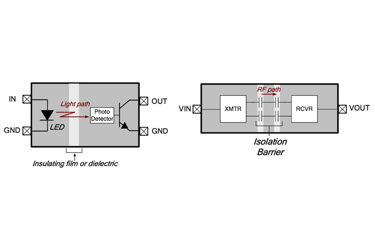Isolator Vs. Optocoupler Technology

Optocouplers have been the unchallenged signal isolation solution for more than four decades, but digital isolators fabricated in complementary metallic oxide semiconductor (CMOS) process technology are gaining favor in the design community because of their superior performance, reliability and integration. This white paper explains the underlying technologies of digital optocouplers and digital CMOS isolators with side-by-side performance and reliability comparisons.
Digital Optocouplers and CMOS Digital Isolator Basics
Digital optocouplers are available in several versions, from 4-pin devices costing pennies to expensive higher-speed devices. The most popular, moderately priced optocouplers are typically 8-pin LEDbased devices that require an output side bias voltage and use input-side current to control the output state. Referring to Figure 1, most optocouplers are composed of a light-emitting diode (LED), photo detector and output driver (usually a transistor or buffer). Current flowing though the LED causes emitted light to strike the photo detector, creating a current flow from VDD to the base of the output device, driving the output low. Conversely, the absence of LED current inhibits current flow to the output device, resulting in output logic high.
Get unlimited access to:
Enter your credentials below to log in. Not yet a member of Wireless Design Online? Subscribe today.
